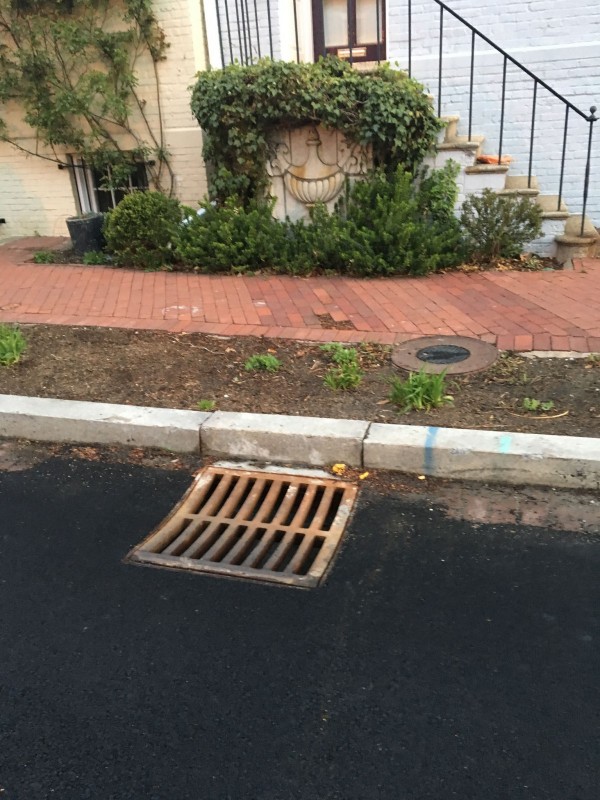Parallel stormwater grates can endanger cyclists. If you see one, say something.

Image by KTesh licensed under Creative Commons.
DC Water plays a small yet important role in making District streets safe and usable for bicyclists. While the District Department of Transportation (DDOT) takes care of nearly all of our street and sidewalk infrastructure, DC Water maintains stormwater drains and grates. Grates with bars in the direction of travel mean big trouble for bicyclists.
Drivers and bicyclists prefer smooth surfaces for their trips. However, obstacles like potholes, utility repairs and road debris, streetcar tracks, and some stormwater grates can require lane changes or even cause wrecks for cyclists. Grates oriented in the direction of traffic are more than an inconvenient bump — they’re downright dangerous. A bicycle comes to an immediate halt when a wheel gets caught in the grates.
Current standards require bike-friendly grates
The Federal Highway Administration recommends a few different grate designs to minimize risks for bicyclists. Bars can be perpendicular to the direction of travel or, when the bars follow the direction of travel, there can be crossbars up to 6 inches apart to keep wheels from getting caught. There are also designs with small shapes like a hexagon that achieve the same safety effect.
Image by Federal Highway Administration.
DDOT’s Design Guide has additional examples that seem to be even more stringent about the direction of the bars. None of the DDOT examples allow bars in the direction of travel, even with small spacing, nor does DDOT allow diagonal bars.
Image by DDOT.
Storm grates generally belong to DC Water
DC Water maintains approximately 1,400 stormwater grates out of their 25,000+ grates and catch basins. While there are no statistics kept on how many are oriented with or perpendicular to traffic, DC Water remains committed to replacing any that are not bike-friendly. They just don’t have perfect awareness of where those remaining grates are to proactively replace them.
As with other infrastructure in the District, there are exceptions to who fixes what. DC Water doesn’t maintain grates or catch basins on private property, federal highways, elevated structures like bridges and National Park Service land. Overall, if DC water repairs or upgrades a grate or catch basin, it takes full responsibility for restoring the roadway and adjacent sidewalks to their original state.
Replacement of a grate can cost as little as a few hundred dollars if DC Water can simply swap out the grate. If, on the other hand, DC Water needs to dig up the roadway to replace the grate, the excavation and restoration of the roadway can cost a few thousand dollars.
Constituent requests help with grate replacement
Fortunately, DC Water responds to constituent requests when someone notices and reports a non-bike friendly stormwater grate. I first noticed one in December 2016 while biking southbound on 15th Street NW in the bike lanes adjacent to Meridian Hill Park. The grate, oriented in the direction of traffic, forced bicyclists to use only a portion of the bike lane. I didn’t know which entity handled these requests, so I sent it via Twitter to @DCWater with a mention of @DDOTDC, just in case. I also didn't realize that, in my Tweets, I was imprecisely referring to stormwater grates as storm drains.
DC Water humorously advised me that they’d look into it and said that it wasn’t in DDOT’s lane (my pun, not DC Water’s). There was some additional back and forth discussion regarding responsibility. In the end, DC Water replaced the grate with one facing perpendicular to traffic, and then restored the asphalt roadway to its original condition.
Months after this small success, I avoided a similar problem on Reservoir Road NW by steering around a non-bike friendly stormwater grate. I stopped, took a photo, and posted it for @DCWater on Twitter. Within a few weeks, once again DC Water replaced the grate with one turned the other direction. In this case, the traffic lane is relatively narrow, so without the fix a bicyclist would have to move farther into traffic to avoid the hazard. Once again, DC Water returned to restore the asphalt road surface.
This is the Reservoir Road grate after repairs. Image by the author.
Anyone who sees DC Water infrastructure (such as non-bike friendly grates) that need repairs or pose a safety hazard can report it for inspection and, if necessary, replacement. DC Water accepts reports at its 24-hour Command Center by phone at (202) 612-3400 or @DCWater on Twitter, as I reported the two grates for replacement.
All users benefit from well-designed road infrastructure. Stormwater grates with bars in the direction of travel can cause particular problems just for cyclists. Until the day when all those legacy ones have been replaced, DC Water remains ready to accept requests for replacement. If you see one, send a Tweet or make the call, so we all benefit.




